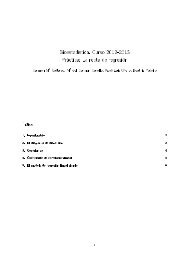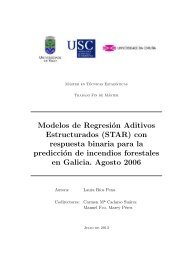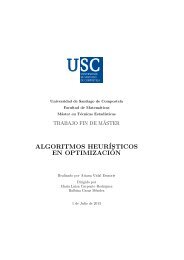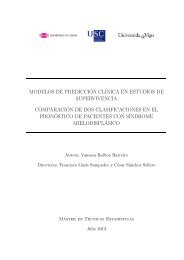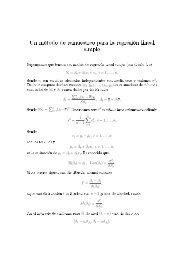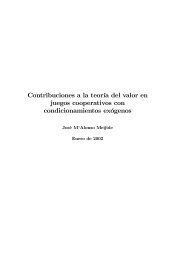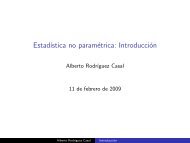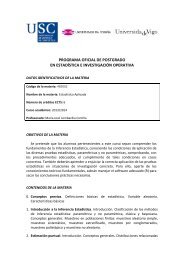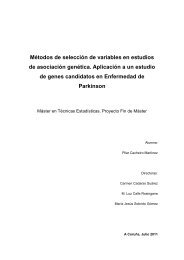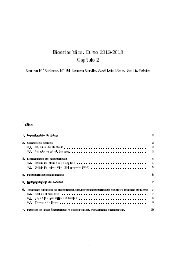Bootstrap independence test for functional linear models
Bootstrap independence test for functional linear models
Bootstrap independence test for functional linear models
You also want an ePaper? Increase the reach of your titles
YUMPU automatically turns print PDFs into web optimized ePapers that Google loves.
Corollary 1. Under the conditions of Theorem 1, if the null hypothesis H 0 : ‖∆‖ ′ = 0 is satisfied,then √ nT n converges in law to Z (X−µX )ε (with covariance operator σ 2 Γ), and consequently, ‖ √ nT n ‖converges in law to ‖Z (X−µX )ε‖.In contrast to Theorem 1 in Cardot, Ferraty, Mas, and Sarda (2003), the result in Corollary 1 isestablished directly on the Hilbert space H instead of on its dual space. In addition, no assumptionof centered X random elements or null intercept term is necessary. Nevertheless these two assumptionscould be easily removed in that paper in order to establish a dual result of Corollary 1.Furthermore, in view of Corollary 1, the asymptotic null distribution of ‖ √ nT n ‖ is not explicitlyknown. This is the reason why no further research on how to use in practice this statistic (or itsdual one) <strong>for</strong> checking if Θ 2 equals 0 is carried out in Cardot, Ferraty, Mas, and Sarda (2003).Instead, an alternative statistic that is used in the simulation section <strong>for</strong> comparative purposes isconsidered. Nevertheless, it is still possible to use ‖ √ nT n ‖ as a core statistic in order to solve this<strong>test</strong> in practice by means of bootstrap techniques.One natural way of using the asymptotic result of Corollary 1 <strong>for</strong> solving the <strong>test</strong> under studyis as follows. Consider a consistent (at least under H 0 ) estimator σn 2 of σ 2 (<strong>for</strong> instance, thesample variance of Y could be used, or perhaps the one introduced by Cardot, Ferraty, Mas, andSarda (2003), provided that its theoretical behavior is analyzed). Then, according to Slutsky’sTheorem ‖ √ nT n ‖/σ n converges in law under H 0 to the norm of Z X . As its covariance operator Γ isunknown, it can be approximated by the empirical one Γ n . And thus, ‖Z X ‖ can be approximatedby ‖Z n ‖, being Z n a centered Gaussian element in H with covariance operator Γ n . Of course, thedistribution of ‖Z n ‖ is still difficult to compute directly, nevertheless one can make use of the CLTand approximate its distribution by Monte Carlo method by the distribution of1m∑(Xi ∗ − X)∥m∥i=1<strong>for</strong> a large value of m, being {Xi ∗}m i=1 i.i.d. random elements chosen at random from the fixedpopulation (X 1 , . . . , X n ). Obviously, this method is a precursor of the bootstrap procedures.In order to complete the asymptotic study of the statistic ‖ √ nT n ‖, its behavior under local alternativesis going to be analyzed. To this purpose, let us consider Θ ∈ H so that ‖Θ 2 ‖ > 0, and givenδ n > 0 consider the modified random sampleY ni= 〈X i , δ n√ nΘ〉 + b + ε i ,<strong>for</strong> all i ∈ {1, . . . , n}. Then, the null hypothesis is not verified. However, if δ n / √ n → 0, then‖(δ n / √ n)Θ‖ → 0, that is, H 0 is approached with “speed” δ n / √ n. In these conditions,E ( (X i − µ Xi )(Y ni− µ Y ni) ) = δ n√ ∆(Θ), nand thus the following theorem that establishes the behavior of the statistic under the consideredlocal alternatives can be easily deduced.Theorem 2. Under the conditions of Theorem 1 and with the above notation, if δ n → ∞ andδ n / √ n → 0 as n → ∞ then(∥ ∥∥∥∥1n∑ (P √n Xi − X ) ( )Yin − Y n)∥ ∥ ∥∥∥≤ t → 0as n → ∞, <strong>for</strong> all t ∈ R.i=16



